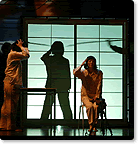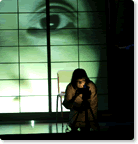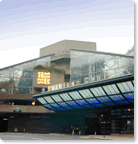- Can you tell us about the historical background of the Barbican?
- The Barbican Centre lies at the heart of a 140,000 square metre residential estate known as the Barbican. A maze of small streets and warehouses before World War II, the area was bombed in December 1940 and completely devastated. In 1955, the first proposal for the area’s development was submitted, and central to the scheme was a large multi-arts centre. The Barbican Centre lies in the City of London (the City for short), which started in the first century and is -one of the oldest areas in Britain. It is a special autonomous area with its own mayor and police. The independent local authority in the City is called the Corporation of London. The Barbican was built as ’the City’s gift to the Nation’ by the Corporation of London at an historical capital cost of 161 million pounds, equivalent to between 400-500 million pounds today. After the Arts Council of England and the BBC, the Corporation of London is the third biggest sponsor for the arts in Britain.
- Would you tell us about BITE seasons?
- Since 1998, the Barbican has become one of the most important promoters of international theatre in Britain through its BITE programme. BITE stands for Barbican International Theatre Events, and initially occupied six months of the year. The season became a continuous year-round programme in summer 2002. The Centre is now the principal presenter of international theatre in the UK, co-commissioning and co-producing theatre, dance and music theatre with international partners as well as presenting the most diverse range of work in Britain. Laurie Anderson, Pina Bausch, Complicite, Merce Cunningham, Philip Glass, Heiner Goebbels, Yukio Ninagawa, Steve Reich, Twyla Tharp, Tom Waits and Robert Wilson are amongst the artists whose work the Barbican has presented in recent years.
- Can you tell us about the latest BITE programme?
- With regard to the new programme from January to June 2005: in January we presented The Plough and the Stars, by the Abbey Theatre from Ireland; and in February a play that portrays the love between Anton Chekhov and Olga Knipper, Ta Main Dans La Mienne, directed by Peter Brook. In April, the very talented director, Deborah Warner, will present Julius Caesar and in May, The End of the Moon by Laurie Anderson, an American performance artist, and Uncle Vanya by Maly Drama Theatre of St Petersburg, Russia. In June, the Merce Cunningham Dance Company from America will be performing Event. A total of twelve theatre companies will be working here.
- Barbican used to be the London home of the Royal Shakespeare Company. What made them leave the Barbican?
-
The Barbican theatre was originally built as the London home of the Royal Shakespeare Company (RSC) but their policy has changed and they decided to present themselves firmly in the West End and different places. In 1996, they told us they were moving out for six months of the year and that gave us an opportunity to run BITE for six months. Major refurbishment of theatre facilities now ensures visits by the broadest range of international theatre companies. And then, in May 2002, the RSC finally left the Barbican.
(At present, the RSC is showing Shakespeare’s plays at the Albery Theatre and performing classical Spanish plays at the Playhouse theatre in the West End, which is the centre of show business in London). - Who owns the Barbican Centre?
- The Barbican is owned, funded and managed by the Corporation of London, the local authority for the City of London. The Corporation of London’s annual revenue grant for the Barbican was approximately 20,530,000 pounds in 2003/2004. From this, the Barbican theatre has an annual programming investment budget slightly less than 2 million pounds for BITE. My responsibility as the Head of Theatre is programming the Barbican Theatre and the Pit.
- How long have you been working at the Barbican? Can you tell us your background in theatre work?
- I joined the Barbican in January 1999. I did a degree at Manchester University studying drama and I started off as a stage manager in repertory theatre. Then, I was a technical director at English National Opera, and I worked as production coordinator at Bayerische Staatsoper, an opera house in Munich. Prior to the Barbican, I was an administrative director of a regional theatre in Britain called Nottingham Playhouse. I have experience both for opera and theatre, and I also have a technical, administrative and creative background.
- Have you ever been to Japan?
- I have been to Japan once, very briefly, to see one of Ninagawa’s productions, Modern Noh Play at Sainokuni Saitama Arts Theatre in 2001. I have not been to Japan to see a lot of work, but that probably is what I should do.
- How do you choose theatre companies for BITE?
- It’s a really big mixture. First, we choose internationally renowned directors like Ninagawa, Peter Brook, etc. We also like contemporary work that challenges people and forms of theatre, which have not been seen before. We also present contemporary dance and music theatre, which has large musical components but is staged. The most important thing is to have work of the highest quality. Certainly this has nothing to do with quota for countries. We will choose the best work that we can find from three to four different countries, and then we might look at contrast or balance between dance and theatre, great people and newer people and, to a lesser extent, balance of countries. We would not do the whole season with work from one country but at the same time we do not say no to more than one work per country for a season if they are particularly interesting.
- Where go you get information about outstanding theatre companies?
- It’s a mixture of seeing and hearing. I travel a lot internationally to see work.
What I decide to see depends on recommendations from the industry, or going to see other international festivals to see work there. A lot of people write to us with suggestions. Quite often the cultural department of a particular country comes to see us. We get quite a lot of invitations from countries with the view to bring their work here, and often like Ninagawa, when we present a company that was successful, we want to repeat that. - Who are the audience of BITE?
- Audiences change every time. In a sense we are different from a festival. In a festival you may have different people coming to the place as well as local people, seeing lots in a short space of time. Because BITE is extended over the whole year, we feel our audiences are predominantly London based and less tourists, as people are specifically coming to see our work. But, if we have Japanese theatre, a large section of the audience is Japanese.
- What Japanese theatre has been shown at the Barbican? In general, which programme was popular?
- We have shown Ninagawa’s Modern Noh Play, Shintoku Maru, Hamlet and Dam Type Theatre. Another Japanese piece we have done is The Elephant Vanishes, which is collaboration between Complicite and Setagaya Public Theatre. We did Hashirigaki, which is from Theatre Vidy, Lausanne in Switzerland, which had a Japanese actress in it, and Japanese folk music was part of it as well. We presented The Elephant Vanishes twice as it was such a huge success. I think it had a magic combination really. Firstly, it was a great piece of work. Secondly, Complicite and Simon McBurney are so well known here. Thirdly, Murakami has a cult following and is certainly immensely respected in Britain. All of these combined in a fantastic production. With regard to Ninagawa’s productions, I think people do enjoy the insight into Japanese life.
Tickets for Peter Brook’s work were all sold out and is was an incredible success. The Abbey Theatre and dance from Africa have also been well received, The Black Rider directed by Robert Wilson from America was also incredibly successful. And even little quirky unusual things like the Ukulele Orchestra of Great Britain have been a huge hit. - Since BITE has started, have there been any changes in direction?
- We made a slight change of direction when the RSC left full time and BITE was spread over the year. It was just impossible to double our six-month season because that would be stretching the audience too much and we did not really have money to do that. We wanted to present some of the productions for longer, and for the first time we started to produce our own shows. Last year The Black Rider, first presented at the Barbican for five weeks, travelled to San Francisco and Sydney. Julius Caesar by Deborah Warner will be travelling to Paris, Madrid and Luxemburg. Judging by the last six months’ box office, we found that most of our shows have exceeded our expectations in terms of audiences and we have always met our budget. So, I suppose we are doing very well.
- hat is the merit of touring abroad?
- You cannot make a profit even if the theatre travels abroad, but what it does is help to find co-producing partners who are willing to put money into productions and make productions possible. The two projects mentioned above are very expensive projects and we would not be able to do that without co-production partners.
- Are you planning more international collaboration?
- There are possibilities that Complicite and Setagaya Public Theatre will collaborate again and we have already said we would like to be part of that.
- Have you any plans to show any Japanese theatre in future?
- We do not have anything specific in the pipeline but that might change tomorrow or the next day. Of course we are talking to Thelma Holt about the next time we will bring Ninagawa back, but we do not have a fixed date yet.
Louise Jeffreys
Three years since the Royal Shakespeare Company, moved to new premises, the Barbican Centre adopts new strategies

Louise Jeffreys
Head of theatre, Barbican Centre
The Barbican Centre promoting its year-round BITE (Barbican International Theatre Events) program of international theater performances, as well as actively pursuing collaborative productions with overseas companies.
Interviewed with ShinKo Suga



The Elephant Vanishes
Photo by Joan Marcus


Barbican Centre
Designed in the 1960s and constructed in the 1970s, the Barbican Centre was opened on 3 March 1982 by Her Majesty The Queen. Owned, funded and managed by the Corporation of London, the third largest sponsor of the arts in the UK, it was built as ‘the City’s gift to the nation’ at an historical capital cost of £161million, equivalent to almost £400 million today.
the Barbican comprises; a 2,026 seat hall for concerts and conferences; two theatres — the 1,166 seat Barbican Theatre and the flexible 200 seat Pit Theatre; three cinemas (seating respectively 280, 255 and 153); two art galleries: the 1,393 square metre Barbican Art Gallery and the smaller horseshoe shaped Curve; and seven conference suites, etc. John Tusa is the Managing Director and Graham Sheffield, the Artistic Director. The Royal Shakespeare Company was invited to contribute to the planning of the Barbican in the 1960s, though, they have departed from the Barbican in May, 2002.
https://www.barbican.org.uk/
Related Tags

